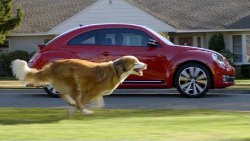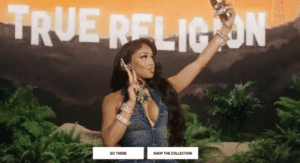In promoting its newly restyled VW Beetle during the live events surrounding Super Bowl XLVI in Indianapolis last month, auto maker Volkswagen chose to steer a novel course. The company had already invested in two 60-second TV spots to be shown during the game broadcast, and in fact had very successfully teased one—the canine chorus “Bark Side” ad—online two weeks before game day. It also had a newly updated design for the Volkswagen Beetle to talk about.
 But in addition to showcasing the car in outdoor ads and street events around Indianapolis, Volkswagen reached out to a digital channel and chose to run location-based ads over JiWire’s Wi-Fi network in cafes, hotels and other public spaces around town.
But in addition to showcasing the car in outdoor ads and street events around Indianapolis, Volkswagen reached out to a digital channel and chose to run location-based ads over JiWire’s Wi-Fi network in cafes, hotels and other public spaces around town.
For days before and after the game, fans who had brought their mobile devices, tablets and laptops to the Super Bowl could log on, view Volkswagen’s “Dog Strikes Back” TV spot, and then continue on to access the Internet.
The location-based campaign used JiWire’s channel of high-traffic public Wi-Fi locations to create zones in and around Lucas Oil Stadium and target those audiences via its “Ads for Access” platform, offering free Wi-Fi connectivity in exchange for viewing the VW ad.
“We brought an opportunity to extend the campaigns for the new Beetle that they already had going [in mass media],” says David Staas, JiWire senior vice president of marketing. “Specifically, we used two approaches to location: on game day for people who were in the vicinity of the stadium for the game, and over the course of the weekend more broadly using a citywide approach. We were thus able to increase those video views over a mobile device, if you were using location-based apps, as well as across laptops, tablets and smartphones that were connecting to public Wi-Fi in places like the local airport, hotels and cafes. No matter how they were connecting to the Internet, we provided an opportunity for Volkswagen to extend that brand presence with views of the new Beetle.”
Volkswagen has had an ad presence at the Super Bowl for the last three years and scored high ratings for last year’s “The Force” spot depicting a child Darth Vader. “For us the Super Bowl is very much about brand awareness, and for us and most other auto manufacturers it has become a very competitive space,” says Charlie Taylor, general manager of digital marketing for Volkswagen Group of America. “Everyone’s trying to say the same things, so it’s important to differentiate. We’ve also noticed that the event has grown beyond a single das to become a few weeks.”
“We had some success [in the pre-game period] with our ‘Bark Side’ video, which wasn’t actually our TV spot but got some 13 million views,” Taylor says. “The lesson there is that you really have to think differently as a marketer now to get your message across through the clutter.”
Volkswagen was already planning to bring all its models to Indianapolis for the game and was looking for an innovative way to extend that message of affordable German engineering built into the “people’s car”. And the brand decided that getting its message out to the millions of devices coming into the city for the game was cutting-edge enough to be noticed and effective without getting in the way of what those travelers wanted: connectivity to enhance their enjoyment of the game.
“JiWire had the capability to reach anyone coming into the city at multiple access points,” he says. “That seemed just another way to reinforce our message of the accessibility of the ‘people’s car’ but also of innovation,” Taylor says.
The preliminary results reinforce the rightness of that decision, Taylor says. Of those who were exposed to VW’s free Wi-Fi offer, 50% accepted and viewed the 60-second spot—and 70% of those watched the entire commercial. Another 25% engaged with the first 30 seconds of the spot before accessing the Web.
Smartphone users who saw the “ads for Access” screen clicked through to the VW site at an average rate of .37% over the course of the multi-day campaign; during the game, that rate rose to .75%. Tablet clickthroughs on game day reached 1.18%. And attendees who accessed mobile apps during the game were presented with a VW brand message, which they clicked through at a rate of .76%.
Other metrics included a 300% increase in Beetle model page traffic over the length of the pre-, during and post-game campaign; some 15,800 online conversations about the car on Super Bowl game day; and a even revitalized interest in last year’s “Force” spot, to the tune of a 100,000 increase in views.
By alternately delivering this year’s two Super Bowl ads in its location-based campaign, Volkswagen was able to rack up 23,664, 285 views, according to social video analyst Visible Measures, placing it first in the automotive category of Super Bowl advertisers for impressions, ahead of Chrysler, Chevrolet, Audi, Toyota, Honda and Acura.
What’s more, says Taylor, ad placement over Wi-Fi at Indianapolis International Airport meant that Volkswagen’s was the last brand message Super Bowl attendees saw before boarding their planes back home.
Branding was purposely light in the JiWire sponsored Wi-Fi campaign—really just the VW logo and a mention of the www.Volkswagen.com address. “The Super Bowl is not really a sales event,” says Taylor. “For us, it’s more focused on name recognition. In terms of engagement, getting people to watch the video was our primary goal. But we saw an 80% lift in our web site traffic, specifically to the Beetle landing page. And car shopping site Edmunds.com has confirmed an 80% lift in shopping consideration of the Beetle on the day of the Super Bowl game and the Monday after.”
Volkswagen has a track record of reliance on mobile marketing to present some of its models. In 2010, the GTI was successfully launched entirely via mobile using text messaging and a branded app, with no mass media advertising at all.
On a side note, JiWire was able to look at the home towns of users who had accessed a JiWire-enabled Wi-Fi network in their home towns and then used those devices to connect while in Indianapolis. According to the company, the most likely travel origins for Super Bowl attendees were Chicago, Boston, Detroit, Dallas and Philadelphia.
As for their access devices of choice, JiWire says 47% of users employed smartphones, compared to 29% who brought laptops and 24% using tablets. If accurate, that would mean that about 2.5 times as many game attendees opted for handheld devices over relatively bulky laptop computers.


 Network
Network

